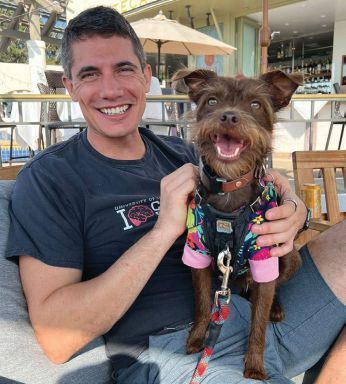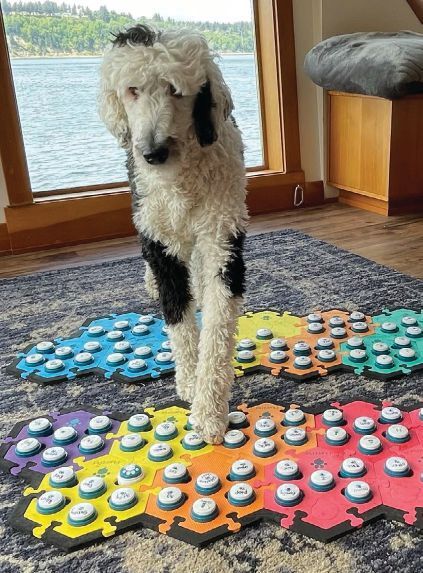The Phenomenon of Button Communication
Driven by the desire to understand the complex capabilities of animals and how humans can tap into that potential to deepen our bond with our pets, Leo Trottier developed the FluentPet Talking Buttons system that is now a viral sensation and used by pets all over the world.
Button communication, a form of assistive language technology, gives your pet not only a voice but also a way for them to understand you better, too. By pressing buttons of pre-programmed speech sounds or words, animal learners can share their requests, thoughts, and feelings. With time and patience, learners have been incredibly successful. Some have not only been able to communicate needs and wants, but also seem to relay more abstract concepts such as feelings or time.
For more than a year, Trottier’s team worked on developing the curriculum at FluentPet. Having sold over 100,000 kits, the team is directly engaged with thousands of successful learners who use an online community-generated forum at How.TheyCanTalk.org. The website is dedicated to helping people teach learners to communicate using soundboard augmentative interspecies communication (AIC) devices.
How.TheyCanTalk.org is inspired by the work of Christina Hunger (see cover story on page 32), who demonstrated that it was possible to teach dogs to use a sound board to express their thoughts and needs. Now, from dogs and cats to birds and horses, many animals are learning to talk to the ones they love most by embarking on this unusual but rewarding journey.

Every participant in button communication is constantly discovering new things about teaching words to dogs, cats, and other species, How.TheyCanTalk.org a place for users to share tips, tricks, and dos and don’ts, all in one space. Currently 3,300 members make up the research forum.
FluentPet’s work with How.TheyCanTalk. org, the research team, and the forum community has helped to distill the company’s knowledge into one official how-to guide.
How did you come to create FluentPet talking buttons?
As a PhD student in cognitive science at UC San Diego, I adopted two cats, and we lived in a small apartment. I noticed how clever they could be and deeply wanted to connect with them. This led to starting a company called CleverPet in 2013. The goal was to develop smart tools that would enable us to understand the animals we live with in new ways while helping to alleviate the boredom they experience.
In the process, with the help of my cofounders, we shipped thousands of CleverPet devices that did, in fact, achieve that goal and which dogs and cats loved. I also learned that not only are dogs and cats able to do things far beyond what most people likely believe, but people want a way to connect and relate to the animals they share their lives with more deeply.
How was Christina Hunger’s work inspirational in the creation of FluentPet?
In 2019, speech language pathologist Christina Hunger showed the world that tools for communicating with non-verbal children can also work to help us communicate with dogs. When I saw video of her dog Stella press “help,” “water,” “outside” after clearly indicating that her “beach” button was missing, I became quickly convinced that a simpler approach could take the place of complicated hardware and software and got to work designing a system that would better meet the needs of people and their companion animals alike. COURTESY FLUENTPET»
COURTESY FLUENTPET»
We launched the FluentPet website in June 2020 and started shipping HexTiles the following August. Sitting here three years later, while creating soundboards for dogs may seem intuitive now, at the time it was not obvious at all how to design such a system.
We iterated through many designs before we arrived at the one we launched. At the time, it was unknown what size the buttons should be, how to keep the mats from sliding around, how to integrate the buttons into mats, how to connect the mats together, etc. We developed a design with interlocking tiles in which buttons fit snugly while providing holes for the button sound to emerge from and allowing people to remove the buttons. These and other ideas are patented (see US patent 11,638,414).
So designing the product wasn’t simple. Can you take us through that process?
The design was based on design principles that arose from the expertise I’d developed during studies of cognitive science and my work with CleverPet beginning in 2013.
Valuable systematic scientific research that involves animals and learning typically takes years. This kind of research is particularly challenging, because the learners we are working with lack language. Consequently, we approached design from a point of humility, assuming we knew essentially nothing about effective language-like communication with non-human animals.
We believed the fastest way to make progress here would be to nurture a community capable of three elements: 1) trying out a wide range of different approaches, 2) learning, and 3) sharing their insights rapidly.
Partly for this reason, we chose six-sided “HexTiles,” which enable the greatest flexibility in arrangement, allowing connection to other HexTiles from any of their six sides. Additionally, you’ll notice that the HexTiles have a blank space where the FluentPet logo goes. This was done intentionally so that it’s possible to quickly make “heads or tails” of each HexTile.
We integrated design with the working assumption that dogs might have cognitive capabilities and take an approach to learning and communication, comparable to that of little children. If this held true, then, scientifically, a logical next step was to consider the Fitzgerald Key, a communication tool that has shown real-world success in helping those with language development challenges. There were six broad language categories in the original Fitzgerald Key, and so we created six different HexTile patterns. The patterns themselves were designed to allow for a wide range of different forms of visual and spatial contrast, making it possible for learners to easily understand which HexTile they were observing.
Did you have a test group of dogs to help develop the final product?
To create our testing community, we posted to a Facebook group where button teachers had congregated, and dozens of button teachers applied to be test users. I interviewed each group member individually for their suitability for the group, and we are still working with several of those dogs today.
What makes the FluentPet system different from other available systems?
The FluentPet boards are different than others on the market in several ways—
■ The FluentPet buttons are easy to press, so dogs of all sizes can use them.
■ The HexTile design makes the buttons easier to navigate for the pets.
■ Our boards are lightweight, making them easy to move and easy to mount on walls for spatial concerns.
■ We use colors that can be seen by dogs in the design of our boards.
■ Our next-generation FluentPet Connect system is app-integrated, so a pet parent can get alerts while away from their pet.
Why is organizing words by category helpful to pets?
This is a recommendation based on techniques that have been observed to work well with young children. As far as we know, it is a lot more efficient to remember a small number of concepts in conjunction with a small number of larger categories versus remembering many concepts distributed “randomly” or in an arbitrary way. By distributing the buttons over a wider space and multiple HexTiles, it is easier for a learner to differentiate them, and this helps avoid issues with sloppy, accidental button presses.
How valuable have social media platforms been in connecting you with pets using the FluentPet buttons?
They’ve been great, especially TikTok at first. They’ve inspired people to reconsider the capabilities of their dogs and cats and discover how fascinating “talking” with buttons can be.
One of the most popular FluentPet button users and ambassadors is adorable Sheepadoodle, Bunny, with over eight million followers (@whataboutbunny on TikTok and Instagram).
There are many more “talking pets” on social media using the FluentPet buttons, here are just a few!
■ BilliSpeaks (instagram.com/billispeaks)
■ OhMyMylo (instagram.com/ohmymylo)
■ PicklesandPeachSpeak (instagram.com/picklesandpeachspeak)
■ Ovi_TheSchnauzer (instagram.com/ovi_theschnauzer)
■ Waffle_the_Supermutt (instagram.com/waffle_the_supermutt)
■ JustinBieberTheCat (instagram.com/justinbieberthecat)

